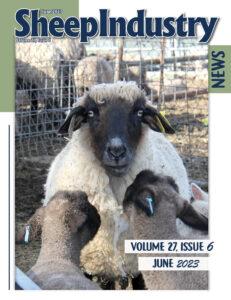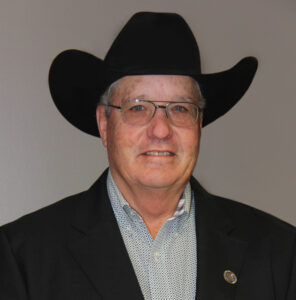HEATHER PEARCE
ASI Wool Production Programs Manager
Saturday morning at the Maryland Sheep and Wool Festival felt like a rock concert. It was abuzz with excitement and anticipation with fiber enthusiasts itching to get their hands on the best fleeces and yarn.
Conducted May 5-7 at the Howard County Fairgrounds in West Friendship, Md., there were three lines of people – each stretching for almost a quarter of a mile – waiting at the gates. Once they opened, festival goers quickly made their way through the ticket lines and flooded the grounds in search of everything from fleeces to sheep to equipment to food.
It would be easy to attribute the excitement to the fact that 2023 marked the show’s 50th anniversary. But it wouldn’t be entirely accurate, either. Regulars will tell you that it’s like this almost every year. With green grass and trees in full bloom, the fairgrounds welcomed huge crowds and provided warm, sunny weather in recognition of the golden anniversary.
Special events to mark the occasion included a 50th anniversary museum that offered a look back at all of the past festivals. An opening ceremony took time to recognize many of the people who worked tirelessly to create the festival in the early years. They included Dahl Denning, Charlote Dinsmore, Bob Dinsmore, David Greene, Dally Irvine, Nancy Greene and Ann Ruppert.
FESTIVAL BEGINNINGS
The Maryland Sheep Breeders Association has had a wool pool to gather and sell members’ wool for a long time. During one such wool pool, handspinners came to skim off a few of the top-quality fleeces before the rest were bagged and shipped. While this created some logistical issues, it sparked the idea of a market to sell fleeces. Thus started the Maryland Sheep and Wool Festival in 1973, founded by MSBA and directed by Festival Chair Janet Sorrels.
The festival has always focused on creating a place where producers can sell their wool and where fiber artists can come to buy that wool. The festival really opened up the market beyond selling commercially. The economic impact has been huge when you think about the number of visitors and the amount of food, fiber, sheep and sheep supplies sold during the festival. The number of sheep in Maryland has remained fairly constant, but the wool pool has ceased in recent years as so many producers have moved to raising high-quality wool (or hair sheep).
The festival continues to be the flagship event for MSBA and is put on by a dedicated committee led by Chairman Gwen Handler, General Manager Kris Thorne, MSBA President Jeff White and 65 volunteers. With humble beginnings working to connect producers and buyers, the festival is now among the biggest sheep festivals in the United States.
FLEECE SHOW & SALE
No matter when you walk into the Fleece Barn, the place is buzzing with excitement. Here’s how it works. Friday is fleece check-in and judging day. The place is filled with clean, lustrous fleeces as producers and volunteers checking them in. Lee Langstaff runs it like a well-oiled machine, handling the 860 fleeces entered in the show and sale. Fleeces must be for sale – honoring the original intent of the festival – but producers can choose if they will be judged.
Also keeping to tradition, only sheep fleeces are accepted. Nearly 500 fleeces were judged by Letty Kline, Geof Ruppert, Dr. Shawn Ramsey and Zane Bone. Most were in breed classes while 200 competed in the white fleece and natural colored fleece divisions – which can include crossbreds. There are even divisions for uncoated – although still fairly clean – fleeces and down breeds.
“We are eager to draw in more of our meat sheep breeders, who have traditionally not participated much,” said Langstaff. “It’s unfortunate since the handspinners and other fiber artists are increasingly interested in working with wool from breeds such as Southdowns, Suffolks, Shrops, Hamps, Clun Forest, Tunis and others. A few years ago, I added a new class for down-type wool as a separate class from other medium white wools so that they could be more easily found by interested buyers and so they don’t have to compete against the Corries and Finns, etc. as they are such different types. I’m still very interested in getting more participation from these producers since they are surely not getting anything meaningful for their wool from the commercial market.”
Saturday morning is the prime time to sell fleeces and it is a spectacle one has to witness to fully appreciate as hordes of fiber enthusiasts flock to the Fleece Barn to get their hands on one (or 10) fleeces to purchase and take home. There are literally traffic jams trying to get through the isles. Producers set the price and most fleeces are sold by the end of the weekend. Volunteers are also scattered through the barn to help buyers find the right fleece.
The champion fleece in each category is put into the newly named – and in honor of one of the festival’s founders – David Greene Silent Auction. This year’s white grand champion fleece was a gorgeous white, five-inch long fleece with blocky locks and stunning crimp and luster grown by Ruppert Corriedales. It was the kind of fleece that is easy for fiber artists to spin and makes everyone in the barn drool. It sold for an astounding $80 per pound.
More than 700 fleeces were purchased by buyers coming from 30 different states. Coated fleeces – where the sheep wear a coat throughout the year to keep the wool clean – typically sell for about $21 per pound, while uncoated fleeces usually sell for about $17 per pound.
“Handspinners are interested in all kinds of wool, especially unique, well taken-care-of fleeces,” Langstaff said. “This is a great opportunity for producers.”
SHEEP SHOW
Roughly 800 sheep came to the festival and had to be scattered throughout several barns. They kept the two show rings constantly busy throughout the weekend with breed and wool shows. The bleachers and all the way around the rings were crowded with onlookers throughout the weekend. Past numbers – when sheep numbers in the United States were higher – climbed upwards of 1,250 sheep.
While less base breeds such as Rambouillet and Corriedale participate, there has been an explosion in natural color and long wool breeds. Producers new and old flock to the show to showcase their wool sheep, which are judged by Dr. Shawn Ramsey and Zane Bone While some sheep excelled in confirmation and some shined in their wool, several excelled in both. The supreme champion drive was held late Sunday afternoon with a supreme champion ram, ewe and fleece awarded.
New this year was the junior show for youth.
“We need more youth involved,” said Dr. Mara Mullinix, who oversees the sheep show. “Youth have new ideas, but we also need to learn from the old, and all stay open minded.”
Walking into the quiet room of the Junior Skillathon, festival goers are struck by how focused the kids are and the variety of sheep related items on the tables. From sheep supplies, to hay, to different feeds, to cuts of lamb, to fleeces, kids are tested on their knowledge of the items. It’s a great, fun way to educate the next generation on the many aspects on raising sheep.
BOOTHS
Approximately 250 booths were scattered in almost every building, tent, nook and cranny throughout the expansive fairgrounds. The main exhibit barn was packed with yarns, pelts, trinkets and even wool pillows. Outside booths offered wool shoes, honey and sheep supplies. If you’re into local food, music, fiber arts or are just an animal lover, this was the place to do your Christmas, birthday, mother’s day, and every other holiday’s shopping for the year.
SEMINARS
Seminars were held the week prior to and during the festival and are not only for fiber artists. There were also classes specifically for producers, such as the How to Produce a Nice Fleece class. Other producer classes revolved around pest management, antibiotics, animal welfare, solar grazing and sheep breeds.
More than two dozen instructors come from across the United States. The classes on spinning were the most popular.
“You can take knitting classes all over, but spinning classes are hard to come by…especially with nationally renowned instructors,” said Lois Greer, the seminars’ co-superintendent. “Some of the classes are extremely popular and fill up fast. It’s like getting Taylor Swift tickets.”
In recent years, there have been about 50 classes held, both on and off-site.
Education came in other forms, as well. An exhibit on antique shearing equipment had people staring in awe at the old cutters, handpieces, grinding wheels, sheep bells and more. Sporting an ASI hat and leaning on a shepherd’s crook, this exhibit was prepared by David Greene, a former shearer and one of the festival’s founders.
Producers also had the chance to bid on used shearing blades, fitting stands and feed equipment on Sunday afternoon in the sunshine. The tree-lined outdoor arena drew some of its biggest crowds for a sheep dog demonstration as a Border Collie worked a small flock of sheep. Attendees even had the opportunity to see the evolution of clothing styles through Make It With Wool garments from the past 50 years.
The Maryland Sheep and Wool Festival is truly a place for producers, fiber enthusiasts and anyone looking to enjoy all sheep have to offer. There’s so much to see and do that this article merely scratches the surface.
“It’s wonderful what a group of people working together for a common goal can accomplish,” said Pamela Jenkins, seminars co-superintendent.



